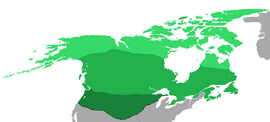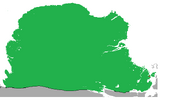| Canada | |
| | 1st of July, 1867 | 11th of December, 1931 | 17th of April, 1982 | 24th of June, 5004 | |
| File:Canada.png | |
| Motto A Mari Usque Ad Mare "From Sea to Sea" | |
| Anthem "O Canada" | |
 Terran Canadian Territory (2100). | |
 Martian Canadian Territory (2100). | |
| Capital | Iqaluit |
| Official languages | English French Spanish |
| Recognised Languages | Inuktitut Inuinnaqtun Cree Dëne Sųłiné Gwich’in Inuvialuktun Slavey Tłįchǫ Yatiì |
| State ideology | Parliamentary Democracy |
| Government | Parliamentary-Presidential Federation |
| Head of State - – |
President |
| Head of Government - – |
Prime Minister |
| Territory | Modern day Canada, Alaska, parts of the northern United States. |
| Population | 1.9 Billion (2100) |
| Currency | Canadian Dollar $ |
Canada's rise to superpower status is largely because of climate caused migration from the rest of the Americas. Much like Sinosiberia, most of the population is 1st or 2nd generation climate refugees. Thanks to climate change most of the country is now habitable. Canada's territory includes Alaska, parts of the northern United States and a number of overseas territories. Quebec was independent country of its own since the mid-2040s, but the growing movement for it to rejoin Canada resulted in re-unification in 2094. Canada's political system is a combination of the early 21st century, Canadian, and the American political systems, with a number of European influences.
Canadian Renaissance[]
During the late 21st century, when ocean levels had nearly risen by 100 meters, Canada was in the middle of an economic boom. Climate change had made Canada the breadbasket of the Americas; an agrarian powerhouse that by 2062 surpassed the UFE as the Premier producer of grain in the world (although Sinosiberia would have surpassed it within a decade). This economic boom in context to the crippled American economy, resulted in a massive influx of economic and environmental refugees from the US and Mexico. At first most came from the gulf region and south western US; but eventually many US States along the Canadian border began to call for secession and annexation by Canada. With the US government bankrupt, and the ongoing Stop-Loss Protests having caused a total breakdown of the American government's control of the military, the United States government was powerless to enforce its own sovereignty over the border states.
In 2048-51 the US states of Washington, Oregon, North Dakota, South Dakota, Idaho, and Wyoming and Montana all voted to secede from the United States and join Canada as new provinces. The Canadian parliament, however, did not recognize the new territories for fear of international backlash. In 2052, US President Lola Sanchez met with Canadian Prime Minister, Nathan Foster in Philadelphia to negotiate the secession of the border states to Canada. President Sanchez, already dealing with a rebellion in Alaska agreed to sell the states to Canada, as well as Michigan's Upper Peninsula of Superior for a sum of 1 trillion dollars. The Canadian Parliament approved the purchase and paid it over the course of the next decade. The funds were used by the United States to pay down the federal deficit and compensate the members of the Stop Loss movement.
The new states almost immediately assimilated with the other Canadian provinces and the Canadian economy continued to flourish with the greater population. With such an expansive territory, Canada continued to accept many more refugees from around the world and became one of the most dynamic societies in the world. In 2059 Alaska, having been independent from the US for only a decade voted to join Canada as a fellow province, becoming the last terrestrial province to join the nation until Quebec's return to the union in the 2090s.
Following the American states admission as new provinces several amendments were made to the Canada's constitution. A true executive branch was established creating a president who presided over the new Canadian, House of Senate. Canadian citizens were now permitted to seek out private health insurance providers if they were unsatisfied with the Canadian public free healthcare system. Gun control laws were loosened and Canadian citizens could now own one or two handgun, though the process of obtaining it required a license, and had to be 18 years or older, and required to have background checks, to be sure whether or not the person purchasing the gun had no criminal activity in the past or mental disorders of any such.
Canada was flourishing far more then anyone had ever predicted. By the late 2040s it was marked as a potential superpower, and in the 2060s went on the achieve that status. With enough food being produced, and the larger population making the "new industrial revolution" possible, much of the world marvelled at the transformation. However, in the early 2070s as the climate became more hostile, more and more immigrants began to flood into Canada, mainly from Central America and South America. With the population doubling every five years Canada found it's self struggling to avoid catastrophe. Thanks to a number of economic and political reforms put in place by the government, and support of Europe (both from the government and from corporations). Canada was able to overcome these problems. By the start of the next century, Canada was once again stable and prosperous.
